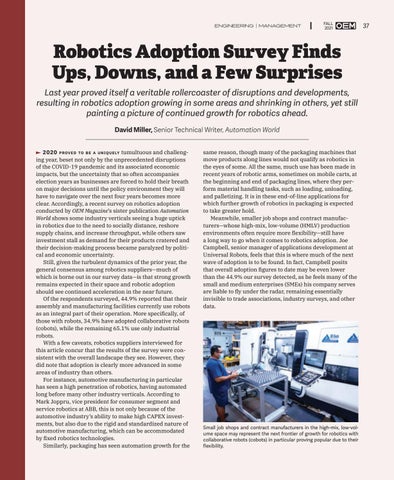ENGINEERING | MANAGEMENT
FALL 2021
37
Robotics Adoption Survey Finds Ups, Downs, and a Few Surprises Last year proved itself a veritable rollercoaster of disruptions and developments, resulting in robotics adoption growing in some areas and shrinking in others, yet still painting a picture of continued growth for robotics ahead. David Miller, Senior Technical Writer, Automation World 2020 PROVED TO BE A UNIQUELY tumultuous and challenging year, beset not only by the unprecedented disruptions of the COVID-19 pandemic and its associated economic impacts, but the uncertainty that so often accompanies election years as businesses are forced to hold their breath on major decisions until the policy environment they will have to navigate over the next four years becomes more clear. Accordingly, a recent survey on robotics adoption conducted by OEM Magazine’s sister publication Automation World shows some industry verticals seeing a huge uptick in robotics due to the need to socially distance, reshore supply chains, and increase throughput, while others saw investment stall as demand for their products cratered and their decision-making process became paralyzed by political and economic uncertainty. Still, given the turbulent dynamics of the prior year, the general consensus among robotics suppliers—much of which is borne out in our survey data—is that strong growth remains expected in their space and robotic adoption should see continued acceleration in the near future. Of the respondents surveyed, 44.9% reported that their assembly and manufacturing facilities currently use robots as an integral part of their operation. More specifically, of those with robots, 34.9% have adopted collaborative robots (cobots), while the remaining 65.1% use only industrial robots. With a few caveats, robotics suppliers interviewed for this article concur that the results of the survey were consistent with the overall landscape they see. However, they did note that adoption is clearly more advanced in some areas of industry than others. For instance, automotive manufacturing in particular has seen a high penetration of robotics, having automated long before many other industry verticals. According to Mark Joppru, vice president for consumer segment and service robotics at ABB, this is not only because of the automotive industry’s ability to make high CAPEX investments, but also due to the rigid and standardized nature of automotive manufacturing, which can be accommodated by fixed robotics technologies. Similarly, packaging has seen automation growth for the
0321_OEM_F3_Tech.indd 37
same reason, though many of the packaging machines that move products along lines would not qualify as robotics in the eyes of some. All the same, much use has been made in recent years of robotic arms, sometimes on mobile carts, at the beginning and end of packaging lines, where they perform material handling tasks, such as loading, unloading, and palletizing. It is in these end-of-line applications for which further growth of robotics in packaging is expected to take greater hold. Meanwhile, smaller job shops and contract manufacturers—whose high-mix, low-volume (HMLV) production environments often require more flexibility—still have a long way to go when it comes to robotics adoption. Joe Campbell, senior manager of applications development at Universal Robots, feels that this is where much of the next wave of adoption is to be found. In fact, Campbell posits that overall adoption figures to date may be even lower than the 44.9% our survey detected, as he feels many of the small and medium enterprises (SMEs) his company serves are liable to fly under the radar, remaining essentially invisible to trade associations, industry surveys, and other data.
Small job shops and contract manufacturers in the high-mix, low-volume space may represent the next frontier of growth for robotics with collaborative robots (cobots) in particular proving popular due to their flexibility.
8/30/21 10:00 AM









